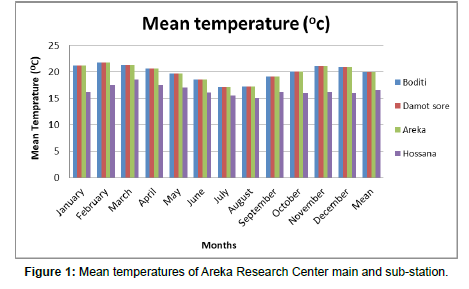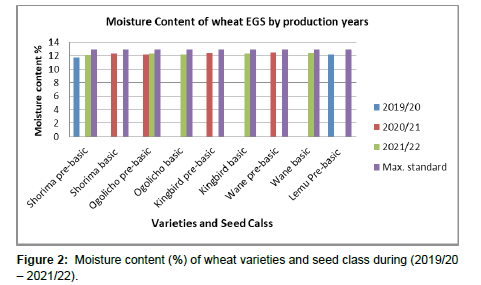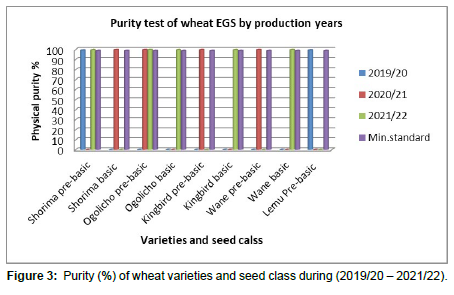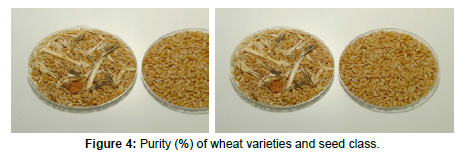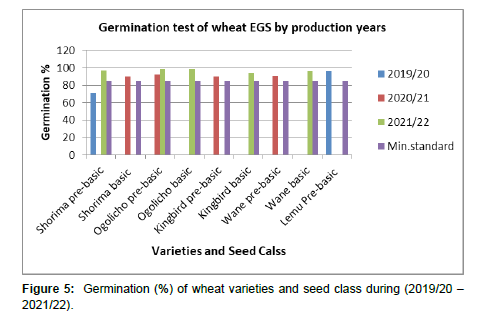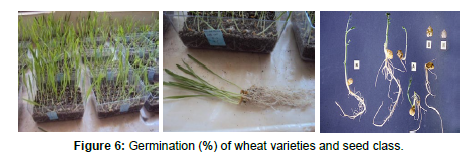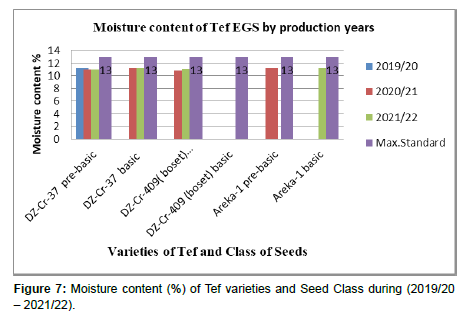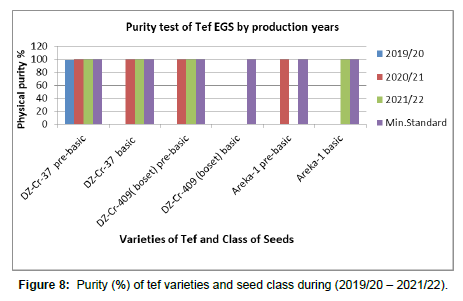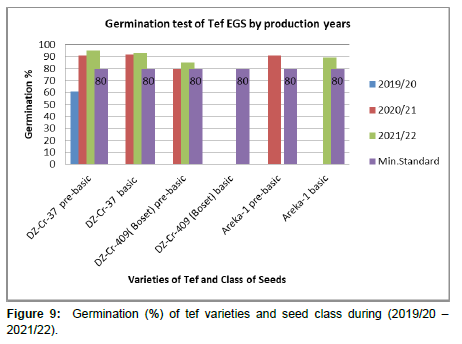Early-Generation Seed Quality Status of Wheat and Tef in Areka Agricultural Research Center, South Agricultural Research Institute
Received: 30-Dec-2022 / Manuscript No. acst-23-85098 / Editor assigned: 05-Jan-2023 / PreQC No. acst-23-85098 / Reviewed: 27-Jan-2023 / QC No. acst-23-85098 / Revised: 17-Feb-2023 / Manuscript No. acst-23-85098 / Published Date: 28-Feb-2023 DOI: 10.4172/2329-8863.1000554
Abstract
Seed quality is defined as a standard of excellence in certain characteristics and/or attributes that will determine the performance of the seed when sown or stored. Seed is the initial input and final output of every crop production system. However, not every production could produce seed because the seed is a living entity that requires special care and several management procedures to meet minimum quality standards. Areka Agricultural Seed Research’s team tests the quality of their seeds yearly, both in the field and laboratory, in the same manner, except for breeder seeds approved by the seed certification agency. The objective of this paper is to briefly review the early-generation seed quality status of wheat and tef in Areka Agricultural Research Center, South Agricultural Research Institute.
The results of the status of quality parameters like moisture content (%), purity (%), and germination (%) varied between 11.8–12.5%, 99.4%–99.9%, and 90–99% for wheat, and 10.8–11.2%, 99.2%–99.9%, and 80–95% for tef, respectively. For the three consecutive years (2019/20–2021/22), the moisture content (%) of all wheat and tef varieties and seed classes met Ethiopia’s minimum standard. For three consecutive years (2019/20-2021/22), the purity (%) of all Wheat and Tef varieties and seed classes met the Ethiopian purity minimum standard. The germination (%) of all wheat varieties and seed classes was higher than the national minimum germination standard, except for Shorima prebasic seed (71%), which did not meet the standard in 2019/20. All tef varieties and seed classes were higher than the national minimum germination standard, except DZ-Cr-37 pre-basic seed (61%), which did not meet the standard in 2019/20. The results from this review indicate that all the varieties and classes of seeds except Shorima Pre-basic and DZ-Cr-37 Pre-basic meet a national minimum standard of Ethiopia for the next EGS production. This shows the quality status of EGS improvement, which indicates that the supply of EGS has increased from time to time.
Keywords
Early Generation Seed; Tef; Wheat; Germination Test; Purity Test
Introduction
Seed quality is defined as a standard of excellence in certain characteristics and/or attributes that will determine the performance of the seed when sown or stored [1]. It is the sum of different aspects of a seed, including its genetic and physical purity, physiological quality, and health quality (Cromwell, 1990). Seed quality is very important to optimum growth and yield production on a farm, which is influenced by many factors such as genetic characteristics, viability, germination percentage, vigor, moisture content, storage conditions, survival ability, and seed health [3]. Quality seed is defined as varietally pure with a high germination percentage, free from disease and disease organisms, and with a proper moisture content and weight [4]. Quality seeds should have a high germination rate and vigor, be genetically and physically pure, be free of seed-borne disease and insect pests, and have low moisture content [5]. Quality seed plays an important role in maximizing the production and productivity of field crops. This resulted in: better germination, vigorous seedling growth, better quality production, and higher crop yields [5, 6]. Rapid and uniform field emergence is essential to achieve better growth and a high yield [7]. The availability, access to, and use of quality seeds of adaptable crops are important in increasing crop production and productivity. It is estimated that the use of quality seed from a variety with high genetic potential (such as the improved varieties) can increase yield by 20–25% [8]. Quality seeds, according to other authors, can increase yield by 5–20% [9].
Early-generation seeds are expected to meet a high standard of varietal purity and seed quality attributes prescribed by national seed regulations [10]. This includes field standards to maintain varietal purity and identity and seed standards in terms of physical, physiological, and health quality. Field inspection is used for the former, and laboratory seed testing is used for the latter. Applying the recommended technical procedures and agronomic management practices [11] during variety maintenance and seed production would ensure the production of EGS of the highest varietal purity, identity, and seed quality. Field standards developed for certifying different crop varieties considered in the Ethiopian seed system include rotation, isolation distance, off-types, and other cultivars, diseases, and noxious weeds. At the same time, for laboratory standards, germination percentage, moisture content, pure seed, weed seed, inert matter, and other crop seeds were measured. All early-generation seeds except breeder seeds are expected to be of the highest seed quality standards, and the subsequent generation of prebasic and basic seeds needs to be inspected, tested, and approved by the seed certification agency [12, 13, 14 ].
Seed testing is required to achieve the objectives of minimizing the risks of planting low-quality seeds, and the primary aim of seed testing is to obtain accurate and reproducible results regarding the quality status of the seed samples submitted to the seed testing laboratories [15]. Samples of seeds of the notified varieties are being sent to the Seed Testing Laboratory of the state for analysis of moisture content, purity, and germination. Seed production should be strictly monitored throughout the crop growth period, from planting through harvesting, drying, threshing, cleaning, packaging, storage, and marketing. Hence, seed producers should understand the principles and procedures for growing a crop for seed, and ensure that all operations are carried out at the right time and in the right place. Therefore, this paper attempts to briefly review the early-generation seed quality status of wheat and tef in Areka Agricultural Research Center, South Agricultural Research Institute.
Results
Areka Agricultural Research Center main and sub-station mean temperature (Figure1)
Early-generation seed (EGS) quality parameters status of wheat (Triticum aestivum L.)
The major attributes of early-generation seed quality status of wheat considered in this review were moisture content, physical purity and standard germination tests of the last three consecutive years (2019/20 – 2021/22).
Moisture Content of wheat EGS
The average moisture content of early-generation seeds of wheat varieties and seed class ranged from 11.8 - 12.5% in the three consecutive years 2019/20 – 2021/22 (Figure 2). The maximum moisture content (12.5%) was found in wane variety pre-basic seed class followed by wane variety basic seed class and kingbird variety pre-basic seed class (12.4%), whereas the minimum moisture content (11.8%) was recorded for Shorima variety pre-basic seed class. The seed moisture contents of the three consecutive years met the seed moisture standard of wheat in Ethiopia (Figure 4).
Physical purity test of wheat EGS
The highest seed purity was recorded by Ogolicho Pre-basic, Kingbird Pre-basic, Wane Pre-basic, Wane Basic, Kingbird Basic, and Shorima Basic, (99.9%) followed by Shorima Pre-basic and Ogolicho Basic with (99.8%) while the lowest seed purity was observed on Shorima Pre-basic with (99.4%) all varieties were fitting the minimum purity standard for next seed production. The maximum inert matter (0.6%) was observed on Shorima Pre-basic while the lowest inert matter (0.1%) was observed on Ogolicho Pre-basic, Kingbird Pre-basic, Wane Pre-basic, Wane Basic, Kingbird Basic, and Shorima Basic (Figure 3).
Germination test of wheat EGS
The highest early-generation seed germination was recorded by Ogolicho Pre-basic and Basic (99%) followed by Shorima Prebasic with (97%) while the lowest seed germination was observed on Kingbird Pre-basic and Shorima basic with (90%) all varieties and seed class were fulfilled the national minimum germination standard for next EGS production except Shorima Pre-basic (71%) did not met during 2019/20 (Figure 5).
The germination percentage and seed moisture content along with storage temperature are highly correlated with increasing predictably with decreasing temperature and moisture content [16]. High seed moisture content along with high temperature and ambient oxygen would trigger series of metabolic changes and increase in respiration and the consumption of storage reserves, and thus lead to seed deterioration [17, 18].
Early-generation seed (EGS) quality parameters status of Tef (Eragrostis tef (Zucc.) Trotter)
The major attributes of early-generation seed quality status of Tef considered in this review were moisture content, physical purity and standard germination of the last three consecutive years (2019/20 – 2021/22).
Moisture content of tef EGS
The average moisture content of early-generation seeds of Tef varieties and seed class ranged from 10.8- 11.2% in the three consecutive years 2019/20 – 2021/22 (Figure 7). The maximum moisture content (11.2%) was found in wane variety DZ-Cr-37 Pre-basic, DZ-Cr-37 Basic, Areka-1 Pre-basic and Areka-1 Basic seed followed by DZCr- 409(Boset) Pre-basic seed class (11.1%), whereas the minimum moisture content (10.8%) was recorded form DZ-Cr-409 (Boset) Prebasic seed class. The seed moisture contents of the three consecutive years met the seed moisture standard of Tef in Ethiopia (Figure 7).
Physical Purity test of Tef EGS
The highest seed purity was recorded by all varieties and class of seed (99.9%) whereas the lowest seed purity was observed on DZ-Cr-37 Pre-basic with (99.2%) all varieties and class were fitting the minimum purity standard for next seed production. The maximum inert matter (0.8%) was observed on DZ-Cr-37 Pre-basic while the lowest inert matter (0.1%) was observed on all varieties and class of seed (Figure 8).
Germination test of Tef EGS
The highest early-generation seed germination was recorded by DZ-Cr-37 Pre-basic (95%) followed by DZ-Cr-37 Pre-basic with (93%) while the lowest seed germination was observed on DZ-Cr-409(Boset) Pre-basic with (80%) all varieties and seed class were fulfilled the national minimum germination standard for next EGS production except DZ-Cr-37 Pre-basic (61%) did not met during 2019/20 (Figure 9).
Summary and Conclusion
Quality seed is the sum of different aspects of a seed, including its genetic and physical purity, physiological quality, and health quality. It should germinate and grow quickly, be genetically and physically pure, be free of seed-borne disease and insect pests, and have low moisture content. Quality seed results in better germination, vigorous seedling growth, better quality production, and a higher crop yield [19]. The use of quality seeds of a variety having high genetic potential (as for the improved varieties) can increase yield by 20–25%. Quality seeds, according to other authors, can increase yield by 5-20%. Seed is a living entity that requires special attention and a variety of management procedures to meet minimum quality standards. Field standards developed for certifying different crop varieties considered in the Ethiopian seed system include rotation, isolation distance, off-types, and other cultivars, diseases, and noxious weeds. At the same time, for laboratory standards, germination percentage, moisture content, pure seed, weed seed, inert matter, and other crop seeds were measured [20].
Except for breeder seeds, which are all approved by external bodies, Areka Agricultural Seed Research’s team tests the quality of their seeds in the field and laboratory on a yearly basis. The status of quality parameters like moisture content (%), purity (%), and germination (%) varied between 11.8–12.5%, 99.4%–99.9%, and 90–99% for wheat; and 10.8–11.2%, 99.2%–99.9%, and 80–95% for tef, respectively. For the three consecutive years (2019/20–2021/22), the moisture content (%) of all wheat and tef varieties and seed classes met Ethiopia’s minimum standard. For three consecutive years (2019/20 to 2021/22), the purity (%) of all wheat and tef varieties and seed classes met the Ethiopian purity minimum standard. All wheat varieties and seed classes met the national minimum germination standard, except Shorima prebasic (71%) did not meet the standard during 2019/20, whereas all tef varieties and seed classes met the national minimum germination standard, except DZ-Cr-37 pre-basic (61%) did not meet the standard during 2019/20 [21,22]. The results from this review indicate that all the varieties and classes of seeds except Shorima Pre-basic and DZCr- 37 Pre-basic meet the national minimum standard of Ethiopia for the next EGS production. This shows the quality status improvement of EGS and indicates that the supply of EGS has increased from time to time.
References
- https://pascal-francis.inist.fr/vibad/index.php?action=getRecordDetail&idt=13659037
- Abebe Atilaw, Dawit Alemu, Zewdie Bishaw, Tekeste Kifle, et al. (2017) Early Generation Seed Production and Supply in Ethiopia: Status, Challenges and Opportunities. Ethiopia J Agri Sci 27(1): 99-119.
- Shewry PR (2009) Wheat research. Wheat journal of experimental Botany 60 (6): 1537-1553.
- https://hos.ifas.ufl.edu/
- https://nduat.org/Doc/anduat.pdf
- https://www.scirp.org/%28S%28351jmbntvnsjt1aadkposzje%29%29/reference/referencespapers.aspx?referenceid=2868174
- Parera CA, DJ Cantliffe (1994) Pre-sowing seed priming. Hort 6: 109-141.
- https://www.bighaat.com/pages/quality-seeds-importance
- Afzal I, Shabir R, Rauf S (2019) Seed production technologies of some major field crops. 655-678.
- https://www.fao.org/fileadmin/templates/mafap/documents/technical_notes/Ethiopia/2005-2013/Ethiopia_Wheat_web.pdf
- Bishaw Z, AA Niane, AJG Van Gastel (2006) Technical Guidelines for Quality Seed Production. ICARDA Aleppo Syria 23: 56-96.
- https://scholar.google.com/scholar?hl=en&as_sdt=0%2C5&q=12.%09Bishaw+Z+Y+Sahlu%2C+B+Semane+%282008%29+The+Staus+of+Ethiopian+Seed+Industry.+p+23-%0932.+IThijssen%2C+M.H.%2C+Zewdie+Bishaw%2C+A.+Beshir+and+%09W.S.+de+Boef%2C+%28eds.%29.+Wageningen+International%2C+Wageningen%2C+the+Netherlands+348+pp&btnG
- Christinck A, Diarra M, Horneber G (2014) Innovations in seed systems. Rep McKnight Found Minneapolis MN 1: 23-53.
- http://publication.eiar.gov.et:8080/xmlui/handle/123456789/3339
- Kshetri B T (2010) On-farm management and quality assessment of farmers saved wheat seed in the western Terai, Nepal. Agronomy J Nepal 1: 50-60.
- https://www.researchgate.net/publication/287346971_Review_of_the_Physiological_and_Biochemical_Reactions_and_Molecular_Mechanisms_of_Seed_Aging
- McDonald M B (1999) Seed deterioration: physiology, repair and assessment. Seed Science and Technology 27(1): 177-237.
- Nadew B B (2018) Effects of Climatic and Agronomic Factors on Yield and Quality of Bread Wheat (Triticum aestivum L.) Seed: A Review on Selected Factors. Adv Crop Sci Techno 6(2): 356-452.
- Prakash Singh, Ravi P Singh, Mukesh Kumar Singh, C Mohapatra (2015) Quality Seed Production,Its Testing and Certification Standard. Seed Pro 52-63.
- Rajjou L, Debeaujon I (2008) Seed longevity: survival and maintenance of high germination ability of dry seeds. Comptes Rendus Biologies 331(10): 796-805.
- Sapkota S, Regmi P P, Pandey S, Tripathi B, Sah S K (2011) Prospects and constraints of formal rice seed systems in Nepal. Agronomy J Nepal 2: 157-167.
- Tripp R, Louwaars N, Van Der Burg, W J Virk D S, Witcombe J R (1997) Alternatives for seed regulatory reform: an analysis of variety testing, variety regulation and seed quality control. Agri Res Extension Network 69: 25-45.
Indexed at, Google Scholar, Crossref
Indexed at, Google Scholar, Crossref
Citation: Sadebo AB (2023) Early-Generation Seed Quality Status of Wheat and Tef in Areka Agricultural Research Center, South Agricultural Research Institute. Adv Crop Sci Tech 11: 554. DOI: 10.4172/2329-8863.1000554
Copyright: © 2023 Sadebo AB. This is an open-access article distributed under the terms of the Creative Commons Attribution License, which permits unrestricted use, distribution, and reproduction in any medium, provided the original author and source are credited.
Share This Article
Recommended Journals
Open Access Journals
Article Tools
Article Usage
- Total views: 2017
- [From(publication date): 0-2023 - Apr 25, 2025]
- Breakdown by view type
- HTML page views: 1674
- PDF downloads: 343

